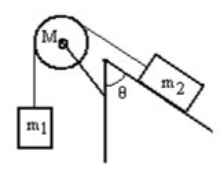A mass m1 is connected by a light string that passes over a pulley of mass M to a mass m2 sliding on a frictionless incline as shown in the figure. There is no slippage between the string and the pulley. The pulley has a radius of 25.0 cm and a moment of inertia of ½ MR2. If m1 is 2.00 kg, m2 is 1.00 kg, M is 4.00 kg, and the angle is 60.0 degrees, then what is the acceleration of m1? 
Definitions:
Ability-To-Pay Principle
The concept that taxes should be levied according to an individual's or entity's ability to bear them, typically resulting in higher earners paying more taxes.
Lump-Sum Taxes
Taxes that are a fixed amount, not dependent on the taxpayer's income or activities, thus they do not distort economic decisions.
Economic Efficiency
A condition where every resource is optimally allocated to serve each individual or entity in the best way while minimizing waste and inefficiency.
Ability-To-Pay Principle
The ability-to-pay principle in taxation suggests that taxes should be levied based on an individual's or entity's capacity to pay, meaning those with higher income should pay more.
Q3: An airplane flies in a vertical, semicircular
Q4: A transverse wave travels at 190 m/s
Q10: A 20.0 kg mass is attached to
Q39: A 4.00 kg mass is moving in
Q46: A transverse periodic wave is represented by
Q53: A pendulum is made by attaching a
Q57: A 100 kg solid spherical rock (I
Q61: Which of the following is a vector
Q62: A 30.0 cm long organ pipe is
Q117: In the figure, an airport luggage-carrying train